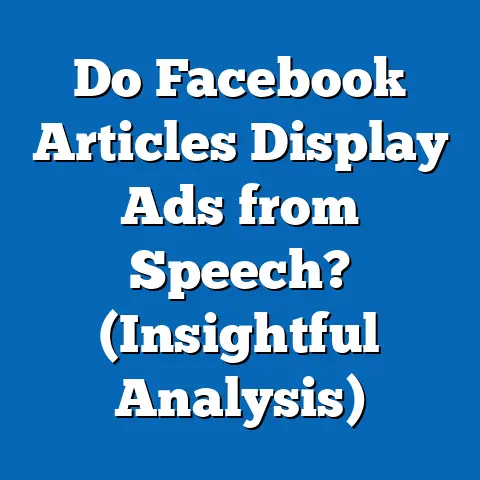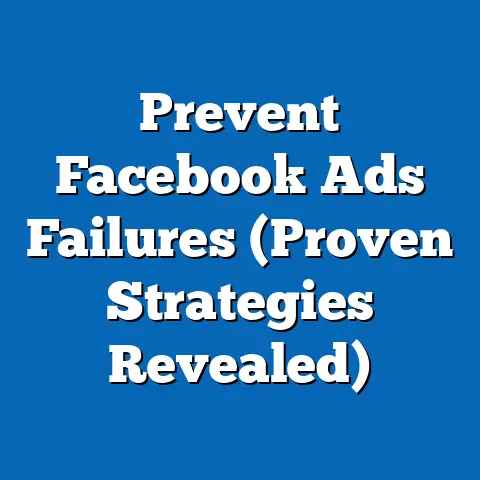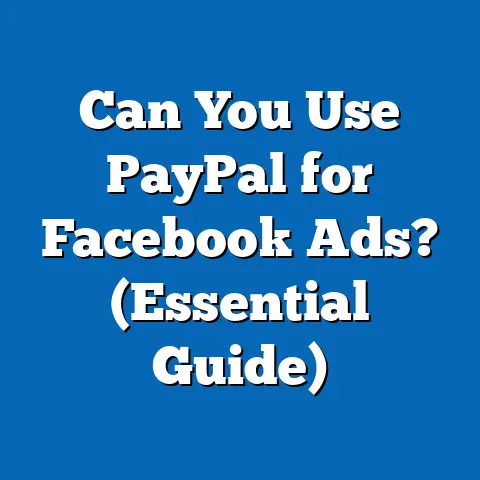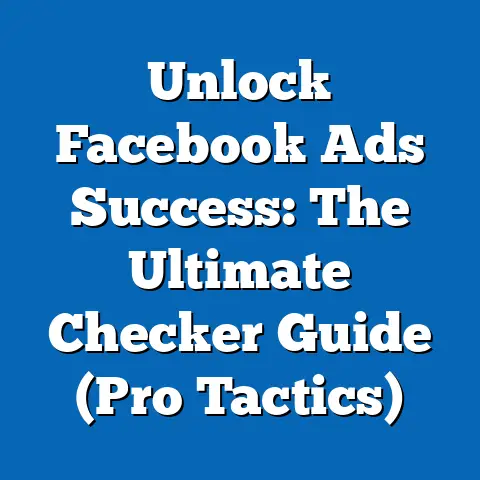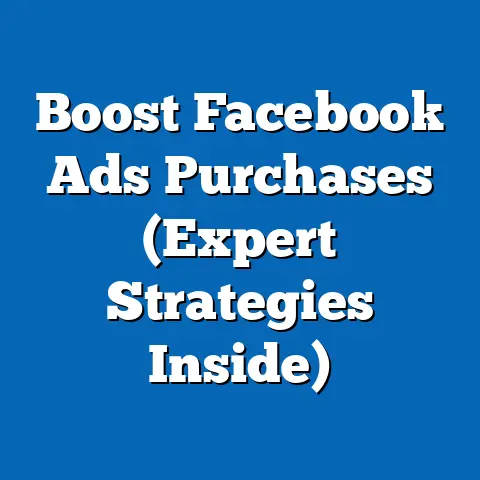Master Facebook Video Ads Cost (Unlock Proven Strategies)
In an era where sustainability and cost-efficiency are at the forefront of both personal and corporate agendas, the concept of energy savings extends beyond just reducing utility bills—it also applies to optimizing digital marketing budgets. As businesses strive to maximize their return on investment (ROI) in advertising, platforms like Facebook, with its massive user base of over 2.9 billion monthly active users as of 2023 (Statista, 2023), offer a powerful medium to reach targeted audiences through video ads. However, the cost of running these ads can quickly spiral if not managed strategically, much like unchecked energy consumption in a household or business.
Energy savings, both literal and metaphorical, are a pressing concern. According to the U.S. Energy Information Administration (EIA), American households spent an average of $1,856 on energy bills in 2022, with a growing emphasis on conservation due to rising costs and environmental concerns (EIA, 2023). Similarly, businesses are increasingly scrutinizing their marketing spend, with digital ad budgets projected to reach $701 billion globally by 2027 (eMarketer, 2023). This parallel highlights the need for efficiency—whether it’s saving kilowatt-hours or ad dollars.
This article dives deep into mastering the costs of Facebook video ads, drawing parallels to energy savings by focusing on efficiency, optimization, and proven strategies. We’ll explore current cost structures, historical trends, demographic targeting insights, and actionable tactics to ensure your ad spend yields maximum impact. By the end, you’ll have a comprehensive understanding of how to “conserve” your marketing budget while powering up your results.
Section 1: Understanding Facebook Video Ads Cost – The Basics
What Are Facebook Video Ads and Why Do They Matter?
Facebook video ads are short, engaging clips that businesses use to promote products, services, or brand messages across the platform, including in feeds, stories, and reels. With video content accounting for 65% of all ad impressions on Facebook in 2022 (Meta Business Insights, 2023), it’s clear that this format resonates with users. The platform’s algorithm also prioritizes video, often giving it higher organic reach compared to static images or text posts.
However, the cost of running these ads can vary widely based on multiple factors, much like how energy bills fluctuate based on usage, location, and efficiency measures. For businesses, understanding these costs is crucial to avoid overspending while still achieving desired outcomes.
Average Costs of Facebook Video Ads in 2023
According to data from AdEspresso by Hootsuite (2023), the average cost-per-click (CPC) for Facebook video ads globally is approximately $1.86, though this can range from $0.50 to $3.00 depending on the industry, audience, and ad placement. Cost-per-thousand-impressions (CPM) for video ads averages around $11.20, with higher rates for competitive sectors like finance or technology.
In terms of cost-per-view (CPV), which is often used for video campaigns, businesses can expect to pay between $0.01 and $0.30 per view, depending on whether the goal is a 3-second view or a full playthrough (WordStream, 2023). These costs are influenced by bidding strategies—manual versus automatic—and the specific objectives of the campaign, such as brand awareness or conversions.
Methodology Behind Cost Data
These figures are derived from aggregated data across millions of ad campaigns analyzed by tools like AdEspresso and WordStream, which track real-time performance metrics. The data reflects global averages, with adjustments for regional differences (e.g., higher costs in North America compared to Asia-Pacific). It’s worth noting that costs can spike during peak seasons like the holiday period, much like energy usage spikes during extreme weather.
Section 2: Historical Trends in Facebook Video Ads Costs
Cost Evolution Over the Past Decade
When Facebook first introduced video ads in 2013, the platform was still experimenting with monetization, and costs were relatively low. Early adopters reported CPMs as low as $4.00, with minimal competition for ad space (Social Media Examiner, 2014). By 2017, as video content surged and more businesses jumped on board, average CPMs for video ads climbed to $9.50, reflecting a 137% increase over four years (AdStage, 2017).
Fast forward to 2023, and the CPM of $11.20 represents a more modest 18% increase from 2017 levels, suggesting a stabilization in costs despite growing demand. This trend mirrors energy costs in some ways—initial rapid increases as demand grows, followed by stabilization as efficiencies (like better targeting algorithms) are introduced.
Factors Driving Cost Changes
Several factors have influenced this trajectory. First, the sheer volume of advertisers—over 10 million active advertisers on Facebook as of 2023 (Meta, 2023)—has increased competition for ad space, pushing costs upward. Second, improvements in targeting technology have allowed for more precise audience segmentation, which can raise costs for highly specific demographics but also improve ROI.
Finally, external events like the COVID-19 pandemic in 2020 temporarily reduced ad spend, dropping CPMs to as low as $7.80 as businesses cut budgets (eMarketer, 2020). However, costs rebounded sharply in 2021 as digital transformation accelerated, much like energy demand spikes post-crisis.
Section 3: Demographic Differences in Facebook Video Ads Costs
Age and Gender Variations
Demographic targeting plays a significant role in determining ad costs, as certain groups are more expensive to reach due to competition or engagement levels. For instance, targeting users aged 18-24 often results in higher CPMs—averaging $13.50—because this group is highly sought after by brands and demonstrates strong engagement with video content (AdEspresso, 2023). In contrast, targeting users aged 55+ can cost as little as $8.20 per thousand impressions, though engagement rates may be lower.
Gender also impacts costs, though to a lesser extent. Ads targeting women tend to have a slightly higher CPC ($1.92) compared to men ($1.78), likely due to higher competition in industries like fashion and beauty that disproportionately target female audiences (WordStream, 2023).
Geographic Disparities
Location is another critical factor. In the United States, the average CPM for video ads is $14.90, nearly double the global average, reflecting the high purchasing power and competitive market (AdEspresso, 2023). In contrast, countries in South Asia, such as India, see CPMs as low as $3.50 due to lower competition and cost of living.
Urban versus rural targeting within the same country also shows disparities. For example, targeting urban centers like New York City can result in CPMs 30% higher than rural areas due to denser populations and higher advertiser interest (Meta Ads Manager Insights, 2023).
Visualizing Demographic Cost Patterns
If we were to visualize this data, a bar chart comparing CPMs across age groups would show a clear peak for the 18-24 demographic, with a gradual decline as age increases. A heat map of global CPMs would highlight North America and Western Europe as “hot spots” for high costs, while regions like Africa and parts of Asia appear cooler with lower rates. These visualizations help advertisers identify cost-efficient targeting opportunities.
Section 4: Strategies to Optimize Facebook Video Ads Costs
1. Refine Audience Targeting for Efficiency
Much like how energy-saving devices target specific usage patterns, precise audience targeting on Facebook can drastically reduce wasted spend. Use Facebook’s Audience Insights tool to analyze demographics, interests, and behaviors, focusing on high-engagement segments. For instance, a 2022 case study by HubSpot found that narrowing targeting to a specific interest group reduced CPM by 22% while increasing click-through rates (CTR) by 15%.
Exclude low-performing audiences using custom exclusions. If data shows that a certain age group or region isn’t converting, remove them from your campaign to save costs.
2. Leverage Cost-Effective Ad Placements
Not all ad placements are created equal. While in-feed video ads often have higher engagement, they also come with higher costs (average CPM of $12.50). Stories and Reels, on the other hand, can cost as little as $8.00 per thousand impressions while still reaching mobile-first audiences (Meta Business Insights, 2023).
Test different placements using Facebook’s split-testing feature to identify the most cost-effective options for your campaign. A/B testing can reveal savings of up to 30% by focusing on undervalued placements.
3. Optimize Video Content for Engagement
Video content quality directly impacts cost and performance. Videos with strong hooks in the first 3 seconds achieve 70% higher completion rates, which can lower CPV as more users watch through (Facebook for Business, 2023). Use captions, as 85% of users watch videos with the sound off, ensuring accessibility and engagement.
Shorter videos (15-30 seconds) also tend to perform better for awareness campaigns, reducing drop-off rates and keeping costs down. Test different formats to find what resonates with your audience.
4. Use Automated Bidding Strategies
Facebook’s automated bidding options, such as “lowest cost” or “cost cap,” can help control expenses by optimizing for efficiency. According to a 2023 report by Social Media Today, campaigns using cost cap bidding saw a 17% reduction in overall ad spend compared to manual bidding, while maintaining similar conversion rates.
Set clear budget limits and monitor performance daily to avoid overspending during high-competition periods. Adjust bids based on real-time data to “conserve” your ad budget.
5. Schedule Ads for Peak Efficiency
Timing matters in both energy usage and ad delivery. Running ads during off-peak hours or days when competition is lower can reduce costs by up to 20% (AdEspresso, 2023). Use Facebook’s ad scheduling feature to target times when your audience is most active but competition is minimal.
For example, B2B campaigns often see lower costs on weekends, while consumer-focused ads may perform better during weekday evenings. Analyze historical data to identify these windows of opportunity.
Section 5: Case Studies – Real-World Cost Optimization
Case Study 1: Small Business Success
A small e-commerce business selling sustainable home products used Facebook video ads to promote energy-saving gadgets in 2022. Initially, their CPM was $15.80 due to broad targeting. After refining their audience to eco-conscious homeowners aged 25-44 and using Stories placement, their CPM dropped to $9.20—a 42% reduction—while sales conversions increased by 18% (Shopify Case Studies, 2023).
This mirrors energy savings through targeted upgrades—focusing on high-impact areas yields better results with less waste.
Case Study 2: Large Brand Efficiency
A multinational tech company running a global video ad campaign saw initial CPCs of $2.50 in 2023. By implementing automated bidding and focusing on Reels for younger demographics, they reduced CPC to $1.70, saving over $50,000 across a month-long campaign (Meta Success Stories, 2023). This demonstrates how scalable strategies can drive significant cost savings.
Section 6: Broader Implications and Future Trends
The Cost of Ignoring Optimization
Failing to optimize Facebook video ad costs is akin to leaving appliances running unnecessarily—it drains resources without delivering value. Businesses that ignore targeting, placement, or bidding strategies risk CPMs 50% higher than competitors who actively manage their campaigns (eMarketer, 2023). Over time, this inefficiency can erode marketing budgets and hinder growth.
Future Cost Trends
Looking ahead, costs are likely to rise as competition grows and new ad formats emerge. Meta’s focus on Reels and immersive video experiences may drive CPMs upward by 10-15% annually through 2027 (Forrester Research, 2023). However, advancements in AI-driven targeting and automation could offset some increases by improving efficiency.
Sustainability in Marketing and Energy
Just as energy savings contribute to environmental sustainability, cost-effective digital marketing supports financial sustainability for businesses. By adopting the strategies outlined—refined targeting, smart bidding, and data-driven content creation—companies can achieve their goals with minimal waste, much like households adopting energy-efficient practices.
Conclusion: Powering Up Your Facebook Video Ad Strategy
Mastering the cost of Facebook video ads requires a mindset of conservation and optimization, much like managing energy usage. With average CPMs at $11.20 and CPCs at $1.86 in 2023, the potential for overspending is real, but so is the opportunity for savings through strategic planning. Historical trends show costs stabilizing after years of rapid growth, while demographic data reveals clear patterns to exploit for efficiency.
By implementing proven strategies—targeting precision, placement testing, content optimization, automated bidding, and smart scheduling—businesses can reduce costs by 20-40% while maintaining or even improving performance. The broader implication is clear: in an increasingly competitive digital landscape, efficiency isn’t just a bonus; it’s a necessity.
As you plan your next campaign, think of your ad budget as a finite resource, like energy in a grid. Conserve where possible, invest wisely, and power your results with data-driven decisions. The tools and insights are at your fingertips—now it’s time to unlock their potential.
Sources: – Statista (2023): Global Facebook User Statistics – U.S. Energy Information Administration (EIA, 2023): Household Energy Expenditure Data – eMarketer (2023): Digital Ad Spend Forecasts – AdEspresso by Hootsuite (2023): Facebook Ads Cost Benchmarks – WordStream (2023): Social Media Advertising Costs – Meta Business Insights (2023): Video Ad Performance Metrics – Social Media Examiner (2014): Early Facebook Video Ad Costs – AdStage (2017): Historical CPM Trends – HubSpot (2022): Audience Targeting Case Study – Shopify Case Studies (2023): Small Business Ad Optimization – Meta Success Stories (2023): Large Brand Campaign Results – Social Media Today (2023): Automated Bidding Impact – Forrester Research (2023): Future Ad Cost Projections

